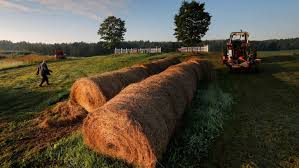21 Oklahoma Counties Under Hay Quarantine: Fire Ants
Mike Seals - July 27, 2021 10:00 am

The United States Department of Agriculture has issued a hay quarantine for 21 counties due to imported fire ants.
The OSU Extension Office said the USDA is having to regulate the transport of hay in many parts of the state due to imported fire ants in the hay.
The counties include Pittsburg, Leflore, McCurtain, Pushmataha, Choctaw, Bryan, Atoka, Coal, Pontotoc, Johnston, Marshall, Murray, Garvin, Carter, Love, Stephens, Jefferson, Comanche, Cotton, Tillman and Jackson.
The USDA’s quarantine ordered said hay grown in those areas can only be sold under set limits by the USDA.
OSU said fire ant nests can house as many as 200,000 ants, they’re invasive and getting rid of them is a long, hard process.
The USDA did not say how the invasion down south happened, but OSU Extension Integrated Pest Management coordinator Tom Royer said in the past, areas of Oklahoma have been infested with imported fire ants through hay donated or bought from other states.
“People often want to sell or donate hay for the best of reasons, from taking advantage of market demand to more altruistically wanting to help other producers who may be lacking valuable feed resources for cattle and other livestock,” said Royer.
He pointed to 2018 when wildfires hit northwestern Oklahoma and burned up hay pastures. Shortly after the fires, people from all over the U.S. brought hay into Oklahoma and some of that was unknowingly infested with imported fire ants.
“Getting rid of them can be a long, hard process, even though control options are well known, and most producers and community officials are willing partners in trying to eradicate the fire ants,” Royer said. “The good news is we’re finding far fewer fire ants in northwestern Oklahoma, generally only around the Laverne area these days.”
Imported fire ants can also damage field crops, vegetable gardens and vineyards, which leads to money loss for farmers. If provoked, fire ants are aggressive and will swarm and sting.
“Cases of people dying from imported fire ant bites are rare but do happen in individuals who are allergic; even if you’re not allergic, the experience of being stung by a swarm is painful,” Royer said. “Swarms have been known to kill small wildlife, and even cause health complications in larger animals.”
The Oklahoma Department of Agriculture Food and Forestry said baled hay that meets any of the requirements below is not regulated and has no movement restrictions:
- For baled hay that is stacked, all bales except the bottom layer that is in direct contact with the ground.
- Hay that is cut, baled, loaded and shipped without storage.
- Baled hay that is stored on an impervious surface such as highly compressed soil (sometimes called hard pan), asphalt or concrete.
- Baled hay that is stored above the soil on pallets or tires or stored on landscaping cloth placed over the soil.
The USDA has posted more information about the hay quarantine online.



